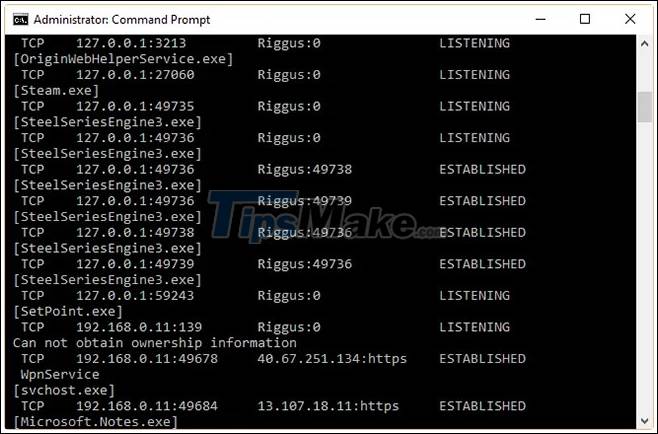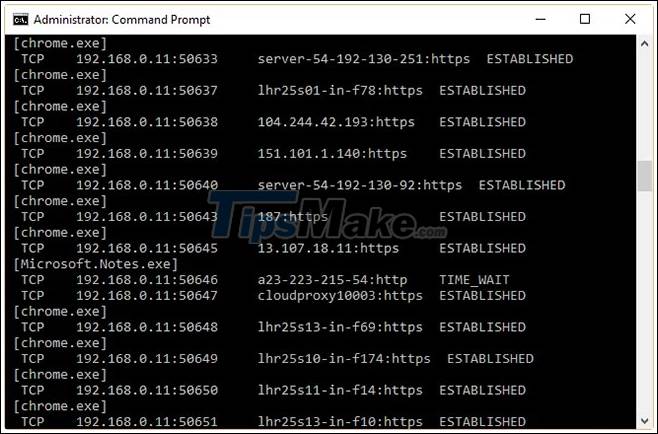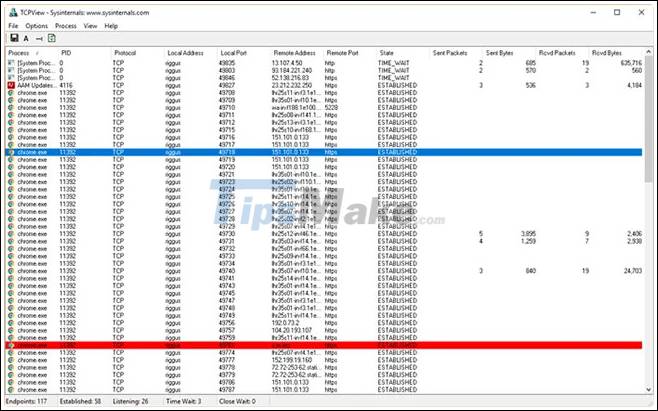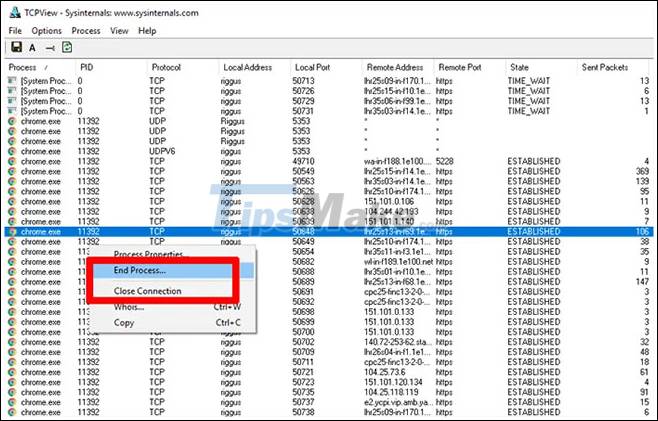How to check the ports in use in Windows 10
At any given moment, a ton of information is sent between your Windows 10 PC and the Internet. This is done using a process in which network-dependent processes look for TCP and UDP ports through which they communicate with the Internet.
In most cases, Windows 10 knows how to manage ports and ensures that traffic is being diverted through the right ports so that those processes can connect to what they need.
But sometimes two processes can be assigned to a single port, or you want to have a better picture of what network traffic is going into and out of your network.
This article will show you an overview of the ports and find out which applications are using which ports.
Command Prompt method
Perhaps the easiest way to see which port is used by which process is to use a trusted Command Prompt.
Click the Start button , type cmd , then right-click on 'Command Prompt' when it shows up in the search results. Click 'Run as administrator' .
Once you are in Command Prompt with admin rights, enter the following command:
netstat -abThis will continuously bring up a list of perhaps quite long ports, along with the Windows processes that are using them. (You can press Ctrl + A , then Ctrl + C to copy all the information to the clipboard). On an average PC there will be two main local IP addresses containing ports on the PC.

The first, in our case, is "127.0.0.1" . This IP address is also known as 'localhost' or 'loopback address' and any processes that listen for ports here communicate internally on the local network without using any network interfaces. The gate is actually the number you see after the colon.

Most of your processes will probably listen for ports prefixed '192.168.xxx.xxx' , which is your IP address. This means that the processes you see listed here are listening for communications from remote Internet locations (such as web pages). Again, the port number is the number after the colon.

TCPView
If you don't mind installing a third-party application and want more control over what's going on with all your ports, you can use a lightweight application called TCPView. The tool immediately lists the processes and their related ports.

What makes this tool better than the Command Prompt is that you can proactively see ports open, close, and send packets. Just pay attention to the green, red, and yellow highlights. You can also reorder the list by clicking on the column header, making it easy to find the process you want, or find two separate processes that compete for the same portal.
If you find a process or connection you want to close, just right-click on it. Then you can choose 'End process' , which is exactly the same function as in Windows task manager. Or you can click 'Close Connection' to let the process open but prevent it from listening on a certain port.

You should read it
- What is port 0 used for?
- How to connect printer 2.0 USB port to USB 3.0 port on Windows 10
- Summary of some simple ways to disable USB ports on Windows computers
- What is AAA PC Port? Why do they have so many problems?
- How to change LPT port in CMOS
- What is DVI port? Classification of popular DVI ports today
- Change port command in Windows
- How to convert WAN port to LAN on router
May be interested
- Whether you are ready or not, Windows 10 laptops will use all USB-C ports
 apple had a hard time giving up all usb-a ports and replacing it with a smaller, more flexible usb-c port on all of its macbook products, and now the laptop running windows 10 also follow them.
apple had a hard time giving up all usb-a ports and replacing it with a smaller, more flexible usb-c port on all of its macbook products, and now the laptop running windows 10 also follow them. - Why do future laptops need USB-C ports on both sides?
 having two usb-c ports that both support power delivery—one on each side—changes the way you work, move, and connect your devices. yet most manufacturers still overlook this essential feature.
having two usb-c ports that both support power delivery—one on each side—changes the way you work, move, and connect your devices. yet most manufacturers still overlook this essential feature. - 4 best ways to check RAM capacity on Windows 11
 ram is an acronym for random access memory. this is a type of memory installed on the motherboard of a computer to store information.
ram is an acronym for random access memory. this is a type of memory installed on the motherboard of a computer to store information. - 5 ways to make use of spare HDMI ports
 many new graphics cards and monitors today prioritize the use of displayport (dp) connections, leaving the hdmi port on many motherboards empty.
many new graphics cards and monitors today prioritize the use of displayport (dp) connections, leaving the hdmi port on many motherboards empty. - How to Open a Gate
 in this article, tipsmake will guide you through opening firewall ports on a router or firewall on a windows computer. by default, key ports in the firewall are closed to prevent intrusion; opening ports can help you solve connection problems between the device and the router, between the program and the device, but it also increases the risk of network and computer attacks.
in this article, tipsmake will guide you through opening firewall ports on a router or firewall on a windows computer. by default, key ports in the firewall are closed to prevent intrusion; opening ports can help you solve connection problems between the device and the router, between the program and the device, but it also increases the risk of network and computer attacks. - The new MacBook supports video and audio output ports
 the latest support material posted on apple's official website today outlines the diagrams and features of the connectivity ports of the new macbook version.
the latest support material posted on apple's official website today outlines the diagrams and features of the connectivity ports of the new macbook version. - Computer buttons and ports
 each computer has a number of buttons and ports that can be found on most desktop computers
each computer has a number of buttons and ports that can be found on most desktop computers - How to check and monitor RAM status on Windows 10
 the computer shows signs of performance loss, or has a blue screen error, then there may be a problem with ram. you need to check and monitor how the status of the ram is.
the computer shows signs of performance loss, or has a blue screen error, then there may be a problem with ram. you need to check and monitor how the status of the ram is. - 6 Common Connection Ports on Laptops and Computers
 you feel confused and do not understand all the connection ports on the computer. hoang ha pc will introduce you to 6 popular connection ports on laptops and computers!
you feel confused and do not understand all the connection ports on the computer. hoang ha pc will introduce you to 6 popular connection ports on laptops and computers! - Summary of some simple ways to disable USB ports on Windows computers
 you can imagine that usb ports are like door scenes, and other users or malware, viruses can spread and access your system anytime through this path. so to protect important data on your windows computer, you can disable the usb port.
you can imagine that usb ports are like door scenes, and other users or malware, viruses can spread and access your system anytime through this path. so to protect important data on your windows computer, you can disable the usb port.










 Fix errors can not merge hard drives, partitions on Windows
Fix errors can not merge hard drives, partitions on Windows 7 great Windows 10 tips and tricks that you need to know
7 great Windows 10 tips and tricks that you need to know How to merge a hard drive in Windows 10 does not lose data with MiniTool Partition Wizard
How to merge a hard drive in Windows 10 does not lose data with MiniTool Partition Wizard How to fix a corrupted Registry on Windows 10
How to fix a corrupted Registry on Windows 10 Top 10 cool features on Windows 10 20H2
Top 10 cool features on Windows 10 20H2 How to fix the error that cannot open Camtasia on Windows 10
How to fix the error that cannot open Camtasia on Windows 10